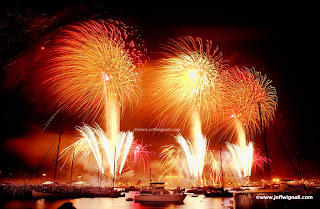 Like everyone, I love going to fireworks displays and the bigger the event (and the longer they last), the better. Hate the crowds, hate the traffic, hate carrying a tripod, but I love the displays. I turn into an instant five year old at the local Fourth of July fireworks and "ooh" and "ahh" at every burst and I'm crushed when they end. I really get a kick out of photographing them, too--though, as usual, I let myself get distracted by photography and shoot far more pictures than I should. In the past few years though I've tried to maintain a balance--half my time shooting, half my time just watching.
Like everyone, I love going to fireworks displays and the bigger the event (and the longer they last), the better. Hate the crowds, hate the traffic, hate carrying a tripod, but I love the displays. I turn into an instant five year old at the local Fourth of July fireworks and "ooh" and "ahh" at every burst and I'm crushed when they end. I really get a kick out of photographing them, too--though, as usual, I let myself get distracted by photography and shoot far more pictures than I should. In the past few years though I've tried to maintain a balance--half my time shooting, half my time just watching.There are actually two different techniques that work for photographing fireworks: in one method you use long time exposures and a tripod and keep the shutter open; in the other you just shoot individual bursts with a handheld camera. I'll cover the former method today and the other tomorrow. Either works fine, but the one I'm going to write about tomorrow is probably simpler and doesn't require a tripod.
Using a tripod and shooting long exposures is the more traditional method of photographing fireworks, I think, and it's the best technique to use if you're trying to include a foreground (as in the shot of New London harbor show here) or when you simply want to fill the shot with lots of different light patterns. It's important to use long exposures and a tripod when the foreground is important because you need time for the darker areas to record. Here’s the basic procedure:
With your camera mounted on a tripod (and I tend to use a relatively wide-angle lens of about 20-28mm in 35mm terms), aim you camera at either the sky (if all you want are the fireworks themselves) or a scene in which the fireworks will play a part. To capture the shot of the harbor, for example, I arrived fairly early and managed to get a shot near the front of the wharf so that I could get the boats and water in the foreground. And at popular events, trust me, getting there early is half of the game.
With your camera set to manual exposure, set the shutter speed to "B" (which stands for "bulb" so that you can make long time exposures. Set the f/stop to a moderately small aperture (f/8 or smaller on a DSLR). I tend also to set a relatively low ISO speed of around 100 or 200 just to keep the very bright explosions from washing out. You will have to experiment with exposures (checking the LCD) as the night progresses.
To make the actual exposure, use a locking cable release (most digital camera makers offer an electronic cable release that has a locking capability) or a cordless remote to fire the shutter. In terms of composition, you pretty much have to wait for the first bursts to hit the sky to decide how to include both sky and foreground because you never know how high the displays are going to go. I often blow the first few shots because I'm still trying to figure out where the fireworks are going to "land" in the sky and often have to reposition the camera a few times to the exact foreground that I want. Don’t panic though if you think you’ve mis-framed the scene, just write-off the first few frames and make your corrections.
Once you think you've captured an interesting assortment of bursts, close the shutter. At this point I usually check the LCD carefully to see how close I am with both exposure and framing and make whatever adjustments are needed. If the fireworks appear to be overexposing (washing out), either use a smaller f/stop or a shorter shutter speed—or both. If the shots are too dark (usually a good thing because you can brighten dark shots a bit in editing, but it's impossible to bring back detail that isn't there), then open the lens slightly or increase exposure time.
Another trick you can use is to place a piece of black cardboard (or a lens cap if you're careful not to jiggle the camera) over the lens between bursts. I find that if the sky is dark enough, that’s not always necessary. Again though, experiment, check your LCD (the picture, not the histogram which is a complete waste of time in this situation because you ARE going to get highlight spikes regardless) and bracket the exposure factors a bit. There is a lot of exposure latitude here provided you're not overexposing. Don't overexpose!
Tomorrow we will look at a simpler, handheld method of photographing fireworks.






2 comments:
Absolutely majestic. And you have a typo in your tag.
One of the techniques I use for shooting fireworks is to hold the DSLR in my hand, and deliberately twist and jiggle it as the fireworks go off. this produces some very cool effects.
Try it sometime, even with boring streetlights and filters can produce really cool results
Post a Comment